Java uses json files to import and export database data
Nov 16, 2020 pm 03:34 PM
Background:
At work, we may encounter situations where we need to quickly move some data in one environment to another environment. At this time, we This can be achieved by importing and exporting json files.
(Learning video sharing: java course)
Example:
We export the user information in the database of this environment into a json format file , and then directly copy the json file to another environment and import it into the database, this can achieve our purpose.
Below I will use springboot to build an import and export case of user data information, and implement the import and export functions of single-user and multi-user database information. After reading this article carefully, you will definitely be able to master the core of importing and exporting json files
Preparation work
Requires maven dependency coordinates:
<dependency>
<groupId>org.springframework.boot</groupId>
<artifactId>spring-boot-starter-web</artifactId>
</dependency>
<dependency>
<groupId>org.springframework.boot</groupId>
<artifactId>spring-boot-starter-actuator</artifactId>
</dependency>
<dependency>
<groupId>org.springframework.boot</groupId>
<artifactId>spring-boot-starter-thymeleaf</artifactId>
</dependency>
<dependency>
<groupId>org.projectlombok</groupId>
<artifactId>lombok</artifactId>
<optional>true</optional>
</dependency>
<dependency>
<groupId>org.mybatis.spring.boot</groupId>
<artifactId>mybatis-spring-boot-starter</artifactId>
<version>2.1.0</version>
</dependency>
<dependency>
<groupId>mysql</groupId>
<artifactId>mysql-connector-java</artifactId>
<version>8.0.18</version>
</dependency>
<dependency>
<groupId>org.springframework.boot</groupId>
<artifactId>spring-boot-starter-jdbc</artifactId>
</dependency>
<dependency>
<groupId>com.alibaba</groupId>
<artifactId>fastjson</artifactId>
<version>1.2.29</version>
</dependency>
<dependency>
<groupId>org.codehaus.jackson</groupId>
<artifactId>jackson-mapper-asl</artifactId>
<version>1.9.13</version>
</dependency>User information in the database:
These field information corresponds one-to-one with the UserEntity entity class in Java
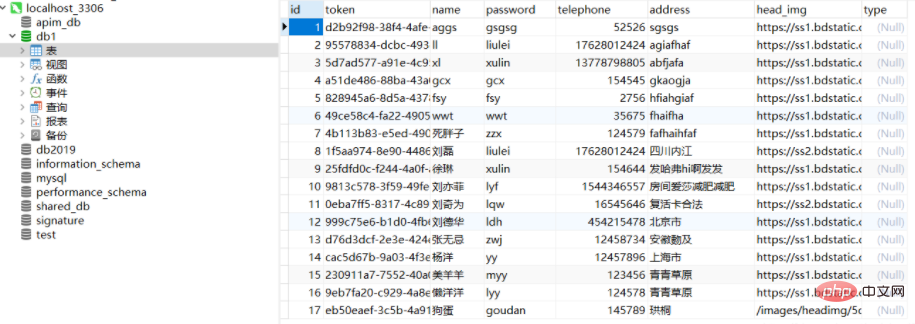
Function implementation
Prepare dependencies and database information After that, we started to build a specific framework for user import and export:
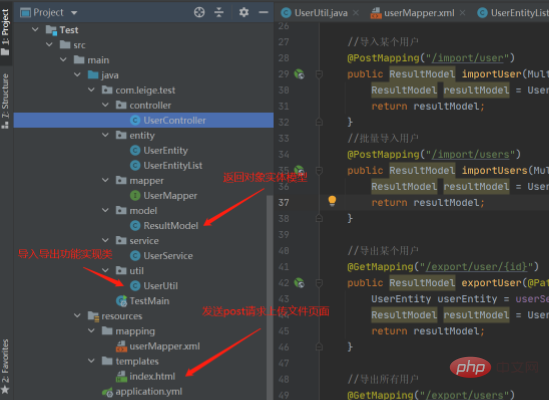
Import and export single-user and multi-user functions to implement UserUtil
package com.leige.test.util;
import com.alibaba.fastjson.JSON;
import com.alibaba.fastjson.JSONObject;
import com.alibaba.fastjson.serializer.SerializerFeature;
import com.leige.test.entity.UserEntity;
import com.leige.test.entity.UserEntityList;
import com.leige.test.model.ResultModel;
import com.leige.test.service.UserService;
import org.apache.commons.io.FileUtils;
import org.codehaus.jackson.map.ObjectMapper;
import org.springframework.util.ObjectUtils;
import org.springframework.web.multipart.MultipartFile;
import javax.servlet.http.HttpServletResponse;
import java.io.*;
import java.net.URLEncoder;
import java.util.List;
import java.util.UUID;
public class UserUtil {
//導(dǎo)入用戶
public static ResultModel importUser(MultipartFile multipartFile, UserService userService) {
ResultModel resultModel = new ResultModel();
try {
// 獲取原始名字
String fileName = multipartFile.getOriginalFilename();
// 獲取后綴名
String suffixName = fileName.substring(fileName.lastIndexOf("."));
//先將.json文件轉(zhuǎn)為字符串類型
File file = new File("/"+ fileName);
//將MultipartFile類型轉(zhuǎn)換為File類型
FileUtils.copyInputStreamToFile(multipartFile.getInputStream(),file);
String jsonString = FileUtils.readFileToString(file, "UTF-8");
//如果是json或者txt文件
if (".json".equals(suffixName) || ".txt".equals(suffixName)) {
//再將json字符串轉(zhuǎn)為實(shí)體類
JSONObject jsonObject = JSONObject.parseObject(jsonString);
UserEntity userEntity = JSONObject.toJavaObject(jsonObject, UserEntity.class);
userEntity.setId(null);
userEntity.setToken(UUID.randomUUID().toString());
//調(diào)用創(chuàng)建用戶的接口
userService.addUser(userEntity);
} else {
resultModel.setStatusCode(0);
resultModel.setStatusMes("請(qǐng)上傳正確格式的.json或.txt文件!");
}
} catch (Exception e) {
e.printStackTrace();
}
return resultModel;
}
//批量導(dǎo)入用戶
public static ResultModel importUsers(MultipartFile multipartFile, UserService userService) {
ResultModel resultModel = new ResultModel();
try {
// 獲取原始名字
String fileName = multipartFile.getOriginalFilename();
// 獲取后綴名
String suffixName = fileName.substring(fileName.lastIndexOf("."));
//先將.json文件轉(zhuǎn)為字符串類型
File file = new File("/"+ fileName);
//將MultipartFile類型轉(zhuǎn)換為File類型
FileUtils.copyInputStreamToFile(multipartFile.getInputStream(),file);
String jsonString = FileUtils.readFileToString(file, "UTF-8");
//如果是json或者txt文件
if (".json".equals(suffixName) || ".txt".equals(suffixName)) {
//再將json字符串轉(zhuǎn)為實(shí)體類
JSONObject jsonObject = JSONObject.parseObject(jsonString);
UserEntityList userEntityList = JSONObject.toJavaObject(jsonObject, UserEntityList.class);
List<UserEntity> userEntities = userEntityList.getUserEntities();
for (UserEntity userEntity : userEntities) {
userEntity.setId(null);
userEntity.setToken(UUID.randomUUID().toString());
//調(diào)用創(chuàng)建用戶的接口
userService.addUser(userEntity);
}
} else {
resultModel.setStatusCode(0);
resultModel.setStatusMes("請(qǐng)上傳正確格式的.json或.txt文件!");
}
} catch (Exception e) {
e.printStackTrace();
}
return resultModel;
}
//導(dǎo)出某個(gè)用戶
public static ResultModel exportUser(HttpServletResponse response, UserEntity userEntity, String fileName){
ResultModel resultModel = new ResultModel();
ObjectMapper objectMapper = new ObjectMapper();
if (ObjectUtils.isEmpty(userEntity)){
resultModel.setStatusCode(0);
resultModel.setStatusMes("此用戶id沒有對(duì)應(yīng)的用戶");
return resultModel;
}else {
try {
String jsonString = objectMapper.writeValueAsString(userEntity);
// 拼接文件完整路徑// 生成json格式文件
String fullPath = "/" + fileName;
// 保證創(chuàng)建一個(gè)新文件
File file = new File(fullPath);
if (!file.getParentFile().exists()) { // 如果父目錄不存在,創(chuàng)建父目錄
file.getParentFile().mkdirs();
}
if (file.exists()) { // 如果已存在,刪除舊文件
file.delete();
}
file.createNewFile();//創(chuàng)建新文件
//將字符串格式化為json格式
jsonString = jsonFormat(jsonString);
// 將格式化后的字符串寫入文件
Writer write = new OutputStreamWriter(new FileOutputStream(file), "UTF-8");
write.write(jsonString);
write.flush();
write.close();
FileInputStream fis = new FileInputStream(file);
// 設(shè)置相關(guān)格式
response.setContentType("application/force-download");
// 設(shè)置下載后的文件名以及header
response.setHeader("Content-Disposition", "attachment;filename="
.concat(String.valueOf(URLEncoder.encode(fileName, "UTF-8"))));
response.setCharacterEncoding("utf-8");
// 創(chuàng)建輸出對(duì)象
OutputStream os = response.getOutputStream();
// 常規(guī)操作
byte[] buf = new byte[1024];
int len = 0;
while((len = fis.read(buf)) != -1) {
os.write(buf, 0, len);
}
fis.close();
os.close(); //一定要記得關(guān)閉輸出流,不然會(huì)繼續(xù)寫入返回實(shí)體模型
return resultModel;
} catch (Exception e) {
resultModel.setStatusCode(0);
resultModel.setStatusMes(e.getMessage());
e.printStackTrace();
return resultModel;
}
}
}
//導(dǎo)出所有用戶
public static ResultModel exportAllUser(HttpServletResponse response, UserEntityList userEntityList, String fileName){
ResultModel resultModel = new ResultModel();
ObjectMapper objectMapper = new ObjectMapper();
if (ObjectUtils.isEmpty(userEntityList)){
resultModel.setStatusCode(0);
resultModel.setStatusMes("此用戶id沒有對(duì)應(yīng)的用戶");
return resultModel;
}else {
try {
String jsonString = objectMapper.writeValueAsString(userEntityList);
// 拼接文件完整路徑// 生成json格式文件
String fullPath = "/" + fileName;
// 保證創(chuàng)建一個(gè)新文件
File file = new File(fullPath);
if (!file.getParentFile().exists()) { // 如果父目錄不存在,創(chuàng)建父目錄
file.getParentFile().mkdirs();
}
if (file.exists()) { // 如果已存在,刪除舊文件
file.delete();
}
file.createNewFile();//創(chuàng)建新文件
//將字符串格式化為json格式
jsonString = jsonFormat(jsonString);
// 將格式化后的字符串寫入文件
Writer write = new OutputStreamWriter(new FileOutputStream(file), "UTF-8");
write.write(jsonString);
write.flush();
write.close();
FileInputStream fis = new FileInputStream(file);
// 設(shè)置相關(guān)格式
response.setContentType("application/force-download");
// 設(shè)置下載后的文件名以及header
response.setHeader("Content-Disposition", "attachment;filename="
.concat(String.valueOf(URLEncoder.encode(fileName, "UTF-8"))));
response.setCharacterEncoding("utf-8");
// 創(chuàng)建輸出對(duì)象
OutputStream os = response.getOutputStream();
// 常規(guī)操作
byte[] buf = new byte[1024];
int len = 0;
while((len = fis.read(buf)) != -1) {
os.write(buf, 0, len);
}
fis.close();
os.close(); //一定要記得關(guān)閉輸出流,不然會(huì)繼續(xù)寫入返回實(shí)體模型
return resultModel;
} catch (Exception e) {
resultModel.setStatusCode(0);
resultModel.setStatusMes(e.getMessage());
e.printStackTrace();
return resultModel;
}
}
}
//將字符串格式化為json格式的字符串
public static String jsonFormat(String jsonString) {
JSONObject object= JSONObject.parseObject(jsonString);
jsonString = JSON.toJSONString(object, SerializerFeature.PrettyFormat, SerializerFeature.WriteMapNullValue, SerializerFeature.WriteDateUseDateFormat);
return jsonString;
}
}1. Start the project and enter in the browser Visit http://localhost:8888/export/users to export all existing user json files

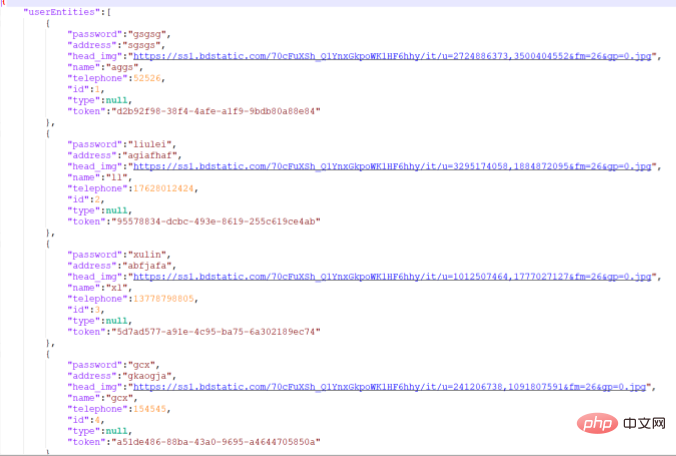
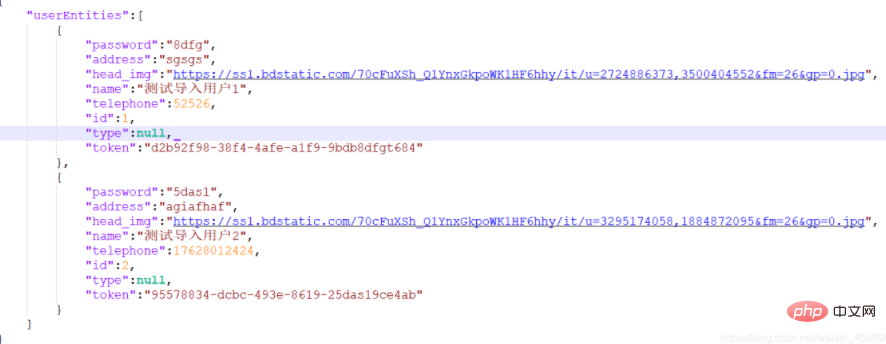

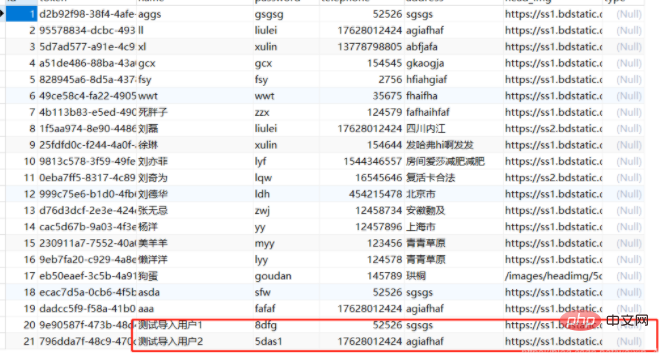
The above is the detailed content of Java uses json files to import and export database data. For more information, please follow other related articles on the PHP Chinese website!

Hot AI Tools

Undress AI Tool
Undress images for free

Undresser.AI Undress
AI-powered app for creating realistic nude photos

AI Clothes Remover
Online AI tool for removing clothes from photos.

Clothoff.io
AI clothes remover

Video Face Swap
Swap faces in any video effortlessly with our completely free AI face swap tool!

Hot Article

Hot Tools

Notepad++7.3.1
Easy-to-use and free code editor

SublimeText3 Chinese version
Chinese version, very easy to use

Zend Studio 13.0.1
Powerful PHP integrated development environment

Dreamweaver CS6
Visual web development tools

SublimeText3 Mac version
God-level code editing software (SublimeText3)

Hot Topics
 How to iterate over a Map in Java?
Jul 13, 2025 am 02:54 AM
How to iterate over a Map in Java?
Jul 13, 2025 am 02:54 AM
There are three common methods to traverse Map in Java: 1. Use entrySet to obtain keys and values at the same time, which is suitable for most scenarios; 2. Use keySet or values to traverse keys or values respectively; 3. Use Java8's forEach to simplify the code structure. entrySet returns a Set set containing all key-value pairs, and each loop gets the Map.Entry object, suitable for frequent access to keys and values; if only keys or values are required, you can call keySet() or values() respectively, or you can get the value through map.get(key) when traversing the keys; Java 8 can use forEach((key,value)->
 Comparable vs Comparator in Java
Jul 13, 2025 am 02:31 AM
Comparable vs Comparator in Java
Jul 13, 2025 am 02:31 AM
In Java, Comparable is used to define default sorting rules internally, and Comparator is used to define multiple sorting logic externally. 1.Comparable is an interface implemented by the class itself. It defines the natural order by rewriting the compareTo() method. It is suitable for classes with fixed and most commonly used sorting methods, such as String or Integer. 2. Comparator is an externally defined functional interface, implemented through the compare() method, suitable for situations where multiple sorting methods are required for the same class, the class source code cannot be modified, or the sorting logic is often changed. The difference between the two is that Comparable can only define a sorting logic and needs to modify the class itself, while Compar
 How to handle character encoding issues in Java?
Jul 13, 2025 am 02:46 AM
How to handle character encoding issues in Java?
Jul 13, 2025 am 02:46 AM
To deal with character encoding problems in Java, the key is to clearly specify the encoding used at each step. 1. Always specify encoding when reading and writing text, use InputStreamReader and OutputStreamWriter and pass in an explicit character set to avoid relying on system default encoding. 2. Make sure both ends are consistent when processing strings on the network boundary, set the correct Content-Type header and explicitly specify the encoding with the library. 3. Use String.getBytes() and newString(byte[]) with caution, and always manually specify StandardCharsets.UTF_8 to avoid data corruption caused by platform differences. In short, by
 Using std::chrono in C
Jul 15, 2025 am 01:30 AM
Using std::chrono in C
Jul 15, 2025 am 01:30 AM
std::chrono is used in C to process time, including obtaining the current time, measuring execution time, operation time point and duration, and formatting analysis time. 1. Use std::chrono::system_clock::now() to obtain the current time, which can be converted into a readable string, but the system clock may not be monotonous; 2. Use std::chrono::steady_clock to measure the execution time to ensure monotony, and convert it into milliseconds, seconds and other units through duration_cast; 3. Time point (time_point) and duration (duration) can be interoperable, but attention should be paid to unit compatibility and clock epoch (epoch)
 How does a HashMap work internally in Java?
Jul 15, 2025 am 03:10 AM
How does a HashMap work internally in Java?
Jul 15, 2025 am 03:10 AM
HashMap implements key-value pair storage through hash tables in Java, and its core lies in quickly positioning data locations. 1. First use the hashCode() method of the key to generate a hash value and convert it into an array index through bit operations; 2. Different objects may generate the same hash value, resulting in conflicts. At this time, the node is mounted in the form of a linked list. After JDK8, the linked list is too long (default length 8) and it will be converted to a red and black tree to improve efficiency; 3. When using a custom class as a key, the equals() and hashCode() methods must be rewritten; 4. HashMap dynamically expands capacity. When the number of elements exceeds the capacity and multiplies by the load factor (default 0.75), expand and rehash; 5. HashMap is not thread-safe, and Concu should be used in multithreaded
 JavaScript Data Types: Primitive vs Reference
Jul 13, 2025 am 02:43 AM
JavaScript Data Types: Primitive vs Reference
Jul 13, 2025 am 02:43 AM
JavaScript data types are divided into primitive types and reference types. Primitive types include string, number, boolean, null, undefined, and symbol. The values are immutable and copies are copied when assigning values, so they do not affect each other; reference types such as objects, arrays and functions store memory addresses, and variables pointing to the same object will affect each other. Typeof and instanceof can be used to determine types, but pay attention to the historical issues of typeofnull. Understanding these two types of differences can help write more stable and reliable code.
 What is the 'static' keyword in Java?
Jul 13, 2025 am 02:51 AM
What is the 'static' keyword in Java?
Jul 13, 2025 am 02:51 AM
InJava,thestatickeywordmeansamemberbelongstotheclassitself,nottoinstances.Staticvariablesaresharedacrossallinstancesandaccessedwithoutobjectcreation,usefulforglobaltrackingorconstants.Staticmethodsoperateattheclasslevel,cannotaccessnon-staticmembers,
 What is a ReentrantLock in Java?
Jul 13, 2025 am 02:14 AM
What is a ReentrantLock in Java?
Jul 13, 2025 am 02:14 AM
ReentrantLock provides more flexible thread control in Java than synchronized. 1. It supports non-blocking acquisition locks (tryLock()), lock acquisition with timeout (tryLock(longtimeout, TimeUnitunit)) and interruptible wait locks; 2. Allows fair locks to avoid thread hunger; 3. Supports multiple condition variables to achieve a more refined wait/notification mechanism; 4. Need to manually release the lock, unlock() must be called in finally blocks to avoid resource leakage; 5. It is suitable for scenarios that require advanced synchronization control, such as custom synchronization tools or complex concurrent structures, but synchro is still recommended for simple mutual exclusion requirements.






